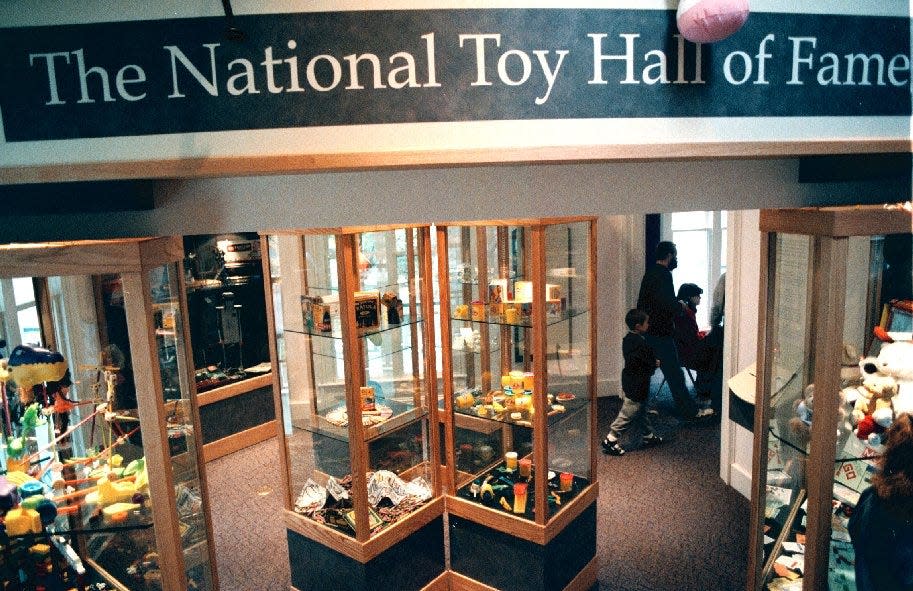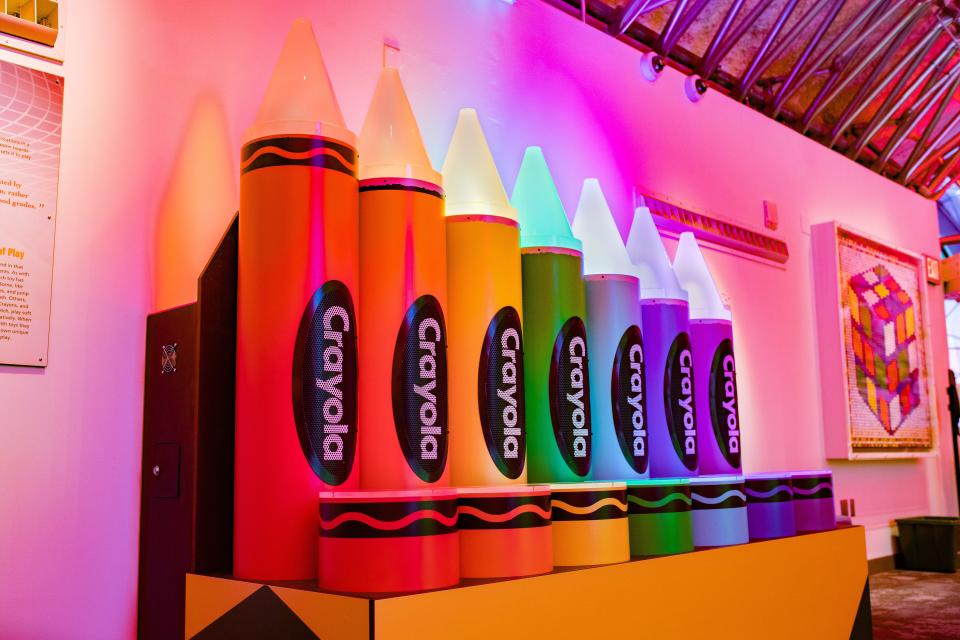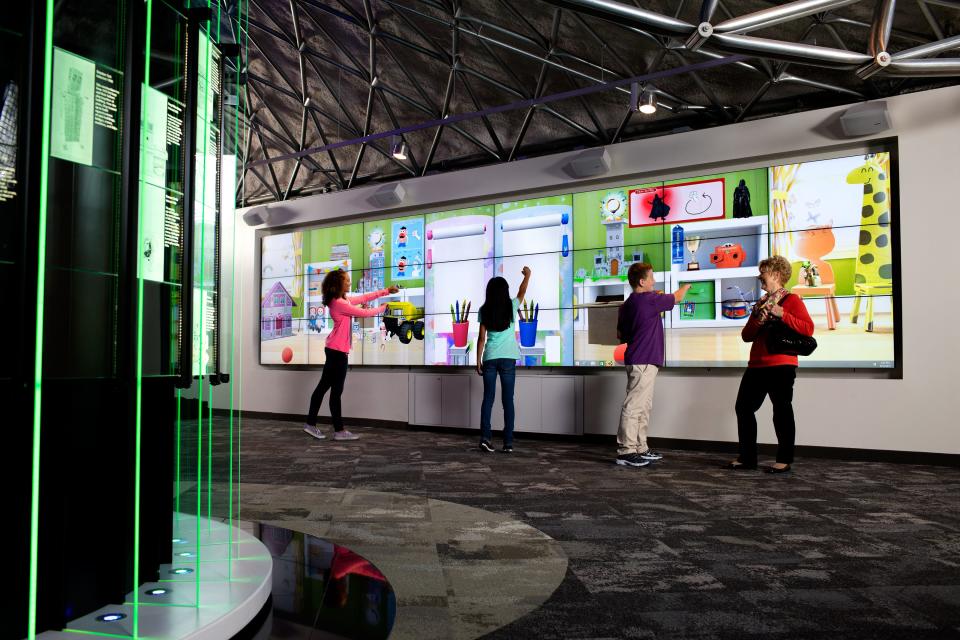National Toy Hall of Fame started in Salem but left in 2002. Why is that?

- Oops!Something went wrong.Please try again later.
This is part of a weekly series answering "Why is that?" questions about Salem and the Mid-Valley.
The question: Why did Salem lose the National Toy Hall of Fame? We have the answer. But first, a little history.
The background: The National Toy Hall of Fame was founded in 1998 in Salem, the brainchild of Ed Sobey, interim director of A.C. Gilbert's Discovery Village. The name had just changed from Gilbert House Children's Museum, which the nonprofit recently returned to using.
Sobey believed a hall of fame for playthings would be a natural fit for a museum named after A.C. Gilbert, a Salem native who invented the Erector Set. It would be the first of its kind in the country, intended to honor toys that foster creativity and learning, benchmarks of the museum's mission.
The museum was barely a decade old and had opened in a century-old house Gilbert lived in as a youth. Today, it has 20 hands-on exhibits spread throughout five historic houses.
Local leaders were gung-ho about the possibilities of the National Toy Hall of Fame. They believed it could be a tourist attraction. Sobey, who commuted every week from his home in Redmond, Washington, expected it to draw national attention not just to Salem but the Willamette Valley and Oregon.
And it did. In the beginning.
The museum put the hall of fame on the first floor of the Parrish House. A committee of local and national educators, civic leaders and toy industry representatives selected the first 11 inductees.
The toys, ranging from Barbie to the Erector Set, were put behind glass, and the hall of fame opened under the spotlight. Crews from three Portland TV stations were in town for a media preview, and life-sized versions of Raggedy Ann, Ken and Mr. Potato Head staged a demonstration before the grand opening.
The Duncan Yo-Yo and the Radio Flyer Wagon led a group of six toys inducted in 1999. Five more joined the hall in 2000, including the bicycle and the spud-shaped toy who picketed before the opening. Tonka Trucks and Silly Putty were the lone inductees in 2001.
But like many a toy in the hand's of a child, the new began to wear off on the hall of fame.
Why did Salem lose the National Toy Hall of Fame?
The National Toy Hall of Fame in the early days was just six glass display cases in the downstairs parlor room of a Victorian house.
Staff at A.C. Gilbert's knew museum members weren't drawn to the exhibit space because the displays changed only minimally once a year, and most of it wasn't hands-on. They also knew visitors who came only to see the hall of fame often left disappointed by its modesty.
The peak of publicity came in early 2002, when a petition circulated worldwide among Raggedy Ann fans lobbying for the doll's induction. A thick packet with 7,300 signatures was delivered to the museum in February. Around the same time the CBS "Early Show" featured a segment with Joni Gruelle Wannamaker, granddaughter of the dolls' creator.
A month later, Raggedy Ann and Andy got in. Wannamaker attended the induction ceremony.
But by fall, museum administrators were preparing to pack up and ship out all the toys, including the beloved floppy dolls.
They had hoped to build on the hype and create a business plan to develop and expand the hall of fame, but it never materialized. Their board of directors seemed to have no interest in multiple proposals and jumped at the opportunity to sell when a children's museum in New York expressed interest.
The bottom line was the National Toy Hall of Fame did not generate attendance or revenue, and the museum did not have the space or money to expand.
A.C. Gilbert's sold the rights to the hall of fame for $225,000 to The Strong Museum in Rochester, New York. Savvy negotiations led to a far better deal than the board expected, and the new owners had to mention A.C. Gilbert's Discovery Village in all promotional materials for several years as part of the sales agreement.
The contents of the hall of fame filled eight cardboard boxes marked handle with care for the 2,235-mile journey via three-day United Parcel Service. The nearly 140 items, examples of the 26 playthings inducted through 2002, were insured for $2,500.
The good news? The deal provided much-needed funding for A.C. Gilbert's, which used some of the proceeds to start an endowment with the Oregon Community Foundation and some to invest in stocks. The endowment has grown, with biannual distributions used to support exhibits and programs, and the fund and stock portfolio continue to provide financial security for the museum in case of emergency.

And the best news? The National Toy Hall of Fame is thriving at what is now known as The Strong National Museum of Play, which opened a 90,000-square-foot expansion in June. The Strong expects annual attendance to grow from its pre-pandemic 600,000 to 1 million by 2026.
An average of 85,000 people visited A.C. Gilbert's each year when the hall of fame was in Salem.
The hall of fame now has 80 toys celebrated in 5,000 square feet of exhibit space at The Strong. It shares space on the second floor with the National Toy Industry Hall of Fame, which recognizes the trailblazers behind the toys, from inventors to retailers.
The Toy Hall of Fame features an interactive gallery where guests can play and explore the inducted toys. They can race a Slinky down a staircase, dress up a giant Mr. Potato Head, or play with Lincoln Logs.
Some of the toys are larger than life.

A Crayon Piano with motion sensors lights up when played, allowing visitors to orchestrate a dazzling music and light show. A giant digital version of the Etch A Sketch magically draws their portrait when they stand in front of the screen. A 20-foot bubble tower enables them to create virtual bubbles that can be moved and popped by motion-capture technology.
Oh, by the way
The Strong will announce the 2023 National Toy Hall of Fame inductees on Thursday. Three will come from a pool of 12 finalists, including Battleship, Ken and Nerf Toys, and one from the "Forgotten Five."
For the first time, one coveted induction spot was left in the hands of the voting public in honor of the hall of fame's 25th anniversary. They had one week in October to choose one of the "Forgotten Five," toys that have been finalists multiple times but haven't got in: Fisher Price Corn Popper, My Little Pony, Pez, Pogo Stick, and Transformers.
The other three inductees were voted on the traditional way, by committee.
Sobey, who launched the hall of fame in Salem, still has a vote.

Capi Lynn is a senior reporter for the Statesman Journal. Email your "Why is that" questions to her at clynn@statesmanjournal.com.
This article originally appeared on Salem Statesman Journal: National Toy Hall of Fame left Salem, Oregon, in 2002. Why?

